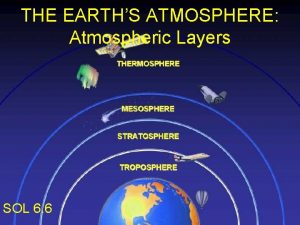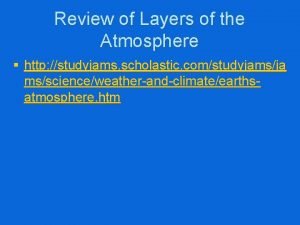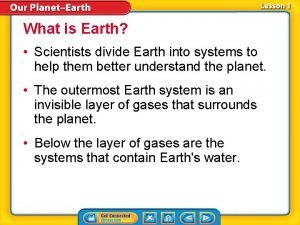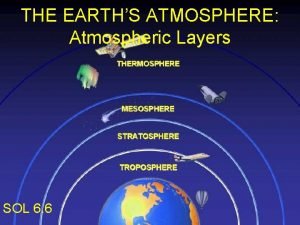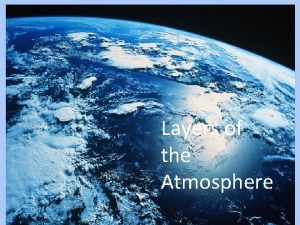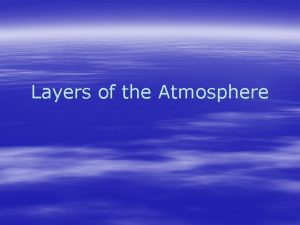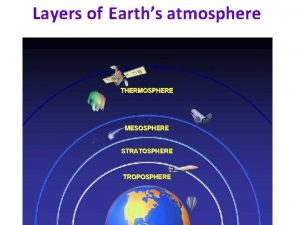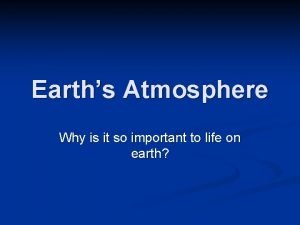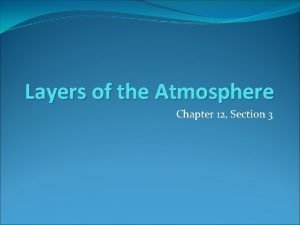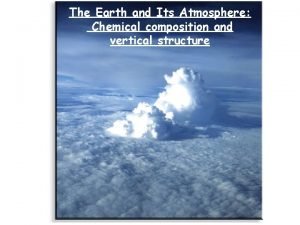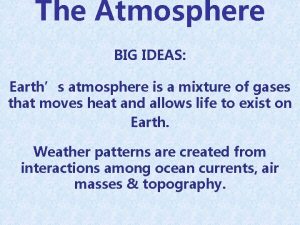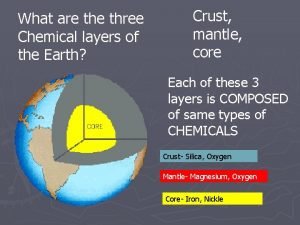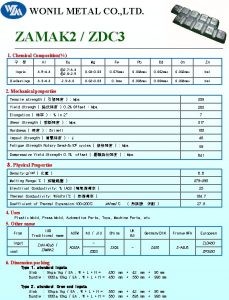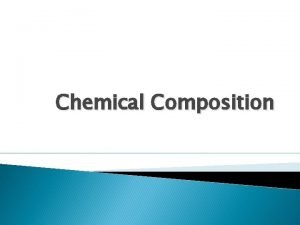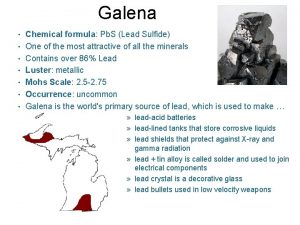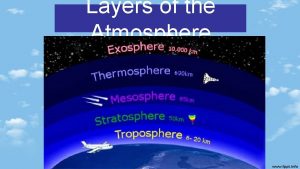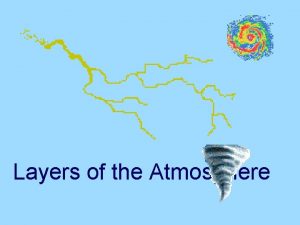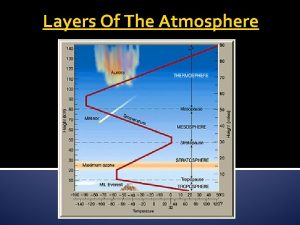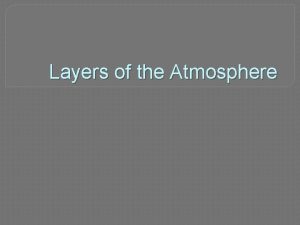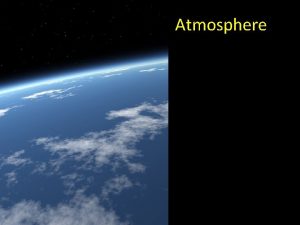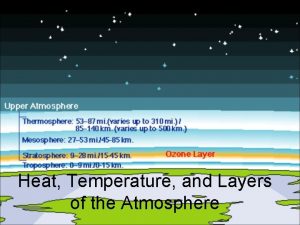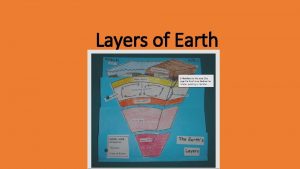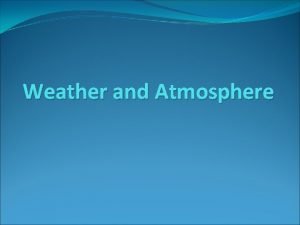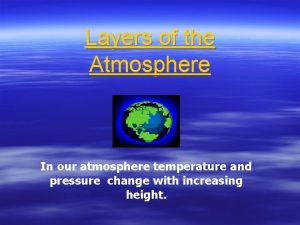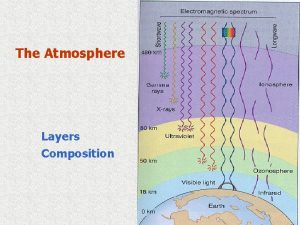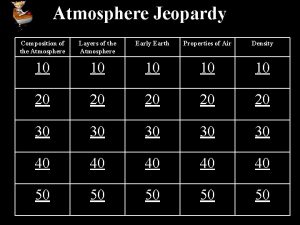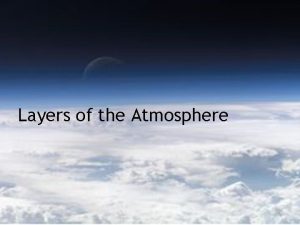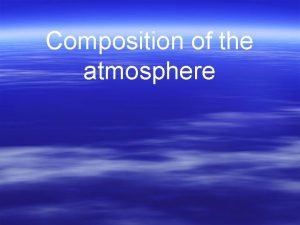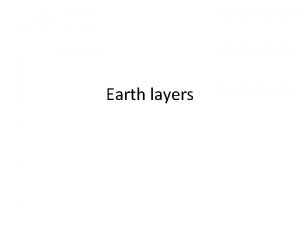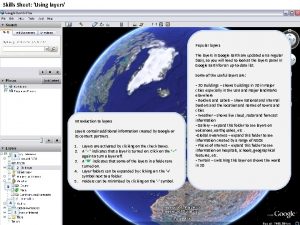Atmosphere Layers of atmosphere Temperature Chemical composition Interaction






















- Slides: 22

Atmosphere • Layers of atmosphere • Temperature • Chemical composition • Interaction with radiant energy

Composition of Air • Air is the name given to the atmosphere used in breathing and photosynthesis. • Air contains about 79% nitrogen • 21% oxygen and • <1% Argon • The remaining gases are referred to as trace gases, including the greenhouse gases such as water vapor, carbon dioxide, methane, nitrous oxide, and ozone. • Air contains about 1% water vapor

Composition of Air

Composition of Air • There are many different types of gasses in the atmosphere • They include nitrogen, oxygen, argon, carbon dioxide and other noble gasses • The gas that is most abundant is nitrogen

Atmospheric Layers • • • Exosphere Outer Space Thermosphere Mesosphere Stratosphere Troposphere Earth

Troposphere • The troposphere begins at the surface and extends to between 9 km at the poles and 17 km at the equator. Average 12 Km • Almost all the earths weather occurs in this layer • Contains 99% of earths water vapor • The troposphere is mostly heated by transfer of energy from the surface. • The lowest part of the troposphere is warmest and temperature decreases with altitude. • Think of climbing a tall mountain. It gets colder as you climb higher

Troposphere •


Stratosphere The stratosphere extends from the about 12 km to about 51 km Almost no weather occurrence. Contains the Ozone Layer (A thin layer of Ozone) Temperature increases with height due to increased absorption of ultraviolet radiation by the ozone layer. • Commercial airliners typically cruise at altitudes of 30, 000– 39, 000 ft in the lower reaches of the stratosphere. • While the temperature may be − 76 °F at the troposphere, the top of the stratosphere is much warmer, and may be near freezing. • • •

Stratosphere •


Mesosphere • The mesosphere extends from about 50 Km to about 80– 85 km • Millions of meteors enter the atmosphere, an average of 40 tons per year. Within the mesosphere, most melt or vaporize as a result of collisions with the gas particles. • Temperature decreases with height in the mesosphere. • In the mesosphere, the temperature is the coldest place on/above Earth and has an average temperature around − 85 °C (− 120 °F) • Water vapor is frozen, forming ice clouds • The main dynamic features in this region are strong zonal (East-West) winds,

Mesosphere

International Space station between the Mesosphere and Thermosphere


Thermosphere • he International Space Station orbits in this layer, between 320 and 380 km • Within this layer, is the ionosphere where Ultraviolet radiation (UV) causes ionization • thermosphere begins about 80 kilometers above the Earth. • Thermosphere temperatures increase with altitude due to absorption of highly energetic solar radiation.

International Space Station •



Exosphere • Is the thin uppermost layer of the Earth’s Atmosphere. • In the exosphere the density is so low that particles collide only rarely. • The exosphere covers all distances where particles are still gravitationally bound to Earth, • Here, the Earth's atmosphere gradually thins out and merges with interplanetary space

Exosphere •

 Layers of the atmosphere song
Layers of the atmosphere song Study jams conductors and insulators
Study jams conductors and insulators Scientists divide the atmosphere into how many layers?
Scientists divide the atmosphere into how many layers? Atmosphere definition
Atmosphere definition Layers of the atmosphere song
Layers of the atmosphere song What is thermosphere
What is thermosphere 1st layer of atmosphere
1st layer of atmosphere Layers of the atmosphere
Layers of the atmosphere 5 layers of the atmosphere
5 layers of the atmosphere The four main layers of the atmosphere
The four main layers of the atmosphere Structure of atmosphere
Structure of atmosphere Hsocl
Hsocl Explain composition and structure of atmosphere
Explain composition and structure of atmosphere Composition of matter which depends on temperature
Composition of matter which depends on temperature Difference between curie temperature and neel temperature
Difference between curie temperature and neel temperature Difference between curie temperature and neel temperature
Difference between curie temperature and neel temperature Ferromagnetis
Ferromagnetis Chemical and physical layers of the earth
Chemical and physical layers of the earth Zamak 5 chemical composition
Zamak 5 chemical composition Mining company profile doc
Mining company profile doc Chemical composition
Chemical composition Human body chemical composition
Human body chemical composition Galena molecular formula
Galena molecular formula
